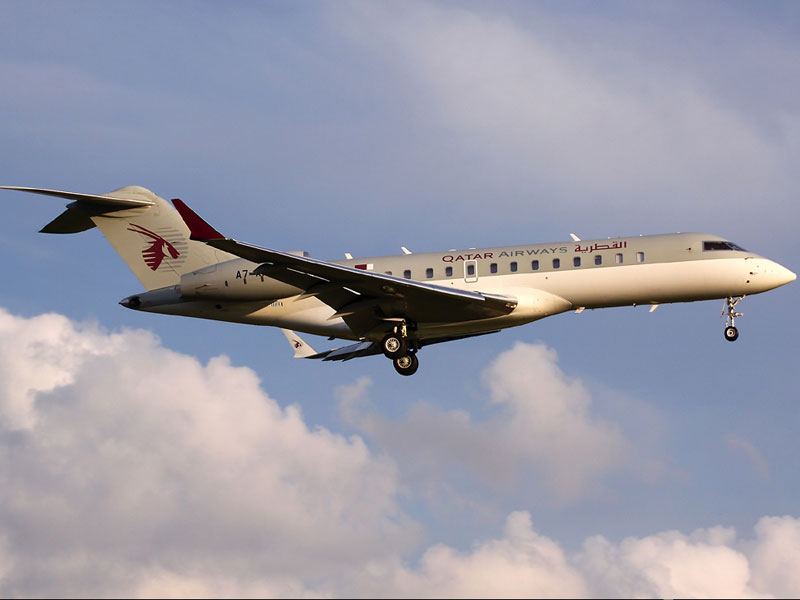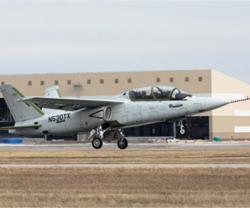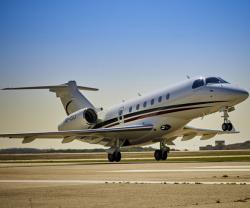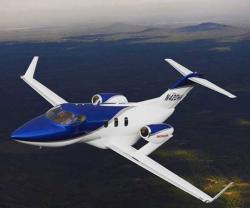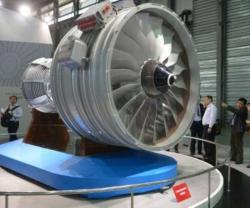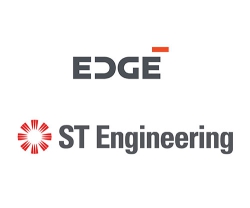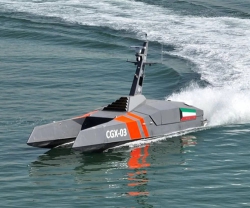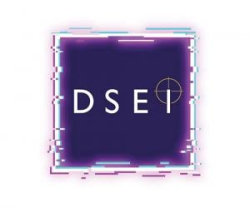Outlook for the Middle East Business Jet Market
06.11.2013 Aviation Space
Business jet operators in the Middle East and Africa (MEA) have indicated their purchases may happen sooner in the next five-year window than expected last year, with about 47% of purchases planned before 2016, a report said.
The share of projected five-year global demand attributed to the Middle East and Africa region moved toward the lower side of its historical 4-7% range this year, according to the 22nd annual Business Aviation Outlook released by Honeywell.
26% of respondents’ fleets are projected to be replaced or added to with a new jet purchase; down from 32% last year, it said.
The level of purchase plans is near the world average even though 2013 has been a year of significant political upheaval and ongoing conflict in the region, according to the report.
Globally, Honeywell is forecasting up to 9,250 new business jet deliveries worth over $250 billion from 2013 to 2022.
The 2013 Honeywell outlook reflects an approximate 3-4% increase in projected delivery value over the 2012 forecast. Despite slightly lower unit deliveries, the expected value comes from pricing increases and a continued change in expected business jet delivery mix, which reflects the ongoing trend toward larger business jet models.
Honeywell forecasts 2013 deliveries of approximately 600 to 625 new business jets, a single-digit decrease over levels reported last year. The reduced deliveries expected in 2013 are largely due to new program delays rather than deterioration in demand.
“2014 industry deliveries are anticipated to be up modestly, reflecting recovery in supply- side constraints and some gains linked to the projected pace of global economic recovery,” said Rob Wilson, President, Honeywell Business and General Aviation.
In its latest survey, Honeywell found that the operators interviewed plan to make new jet purchases equivalent to about 28% of their fleets over the next five years either as a replacement or in addition to the their current fleet. This level of interest has been largely stable for the past four survey cycles, and compares favorably with results of 25% or less that were the norm until 2006.
Of those new business jet purchase plans, 19% are intended to occur by 2014, with larger shares of more than 22% each year scheduled for 2015 and 2016 purchases. The survey does not allocate specific years beyond 2016. This is slightly improved from last year’s results and leads to a modest gain in projected demand in the near term.
Higher purchase expectations continue to focus on larger cabin aircraft classes ranging from super midsize through the ultralong range and business liner, implying these types of aircraft will command the bulk of the value billed from now until 2023.
This large cabin group is expected to account for more than 80% of all expenditures on new business jets in the near term. Volume growth between now and 2023 will be led by this class of aircraft, reflecting nearly 60% of additional units, and nearly 85 per cent of additional retail value.
“The trend toward larger cabin aircraft with ever-increasing range expectations and advanced avionics is seen more strongly than ever in this year’s survey,” Wilson said.
“As a full- spectrum supplier to the industry, Honeywell has been successful in anticipating the needs of and advancing the technological capabilities of the popular super midsize and larger aircraft in production or scheduled to enter service over the next few years,” he added.
“The Honeywell operator survey has been an invaluable tool for the industry over the past two decades,” explained Carl Esposito, Vice President of Marketing and Product Management, Honeywell Aerospace.
“The annual outlook has helped guide our own product decision process, which has led to focused investments such as designing and developing optimized propulsion offerings, flight efficiency upgrades, innovative safety products and enhanced services. It has also contributed to our business pursuit strategy, and helped position Honeywell consistently on high-value platforms in growth sectors.”
“It is critical to understand that survey findings from this part of the world remain based on a smaller base of operator pools and we do not believe the 2013 results represent any structural change in the region’s fundamental underlying growth drivers or commitment to business aviation,” Wilson noted.
“We continue to see underlying macro trends that support potential demand for business jets, making the industry’s long-term prospects attractive,” Wilson said.
“Other factors we believe will help accelerate global business aviation growth are long overdue structural and regulatory reforms, which have the potential to unlock significant spending power that would propel aviation expansion.
Product innovation in the form of Honeywell’s Ka-band satellite communication technology solutions and our SmartView Synthetic Vision System upgrades supports the expanded use of business aircraft as a key tool in the global economy,” he added.
The share of projected five-year global demand attributed to the Middle East and Africa region moved toward the lower side of its historical 4-7% range this year, according to the 22nd annual Business Aviation Outlook released by Honeywell.
26% of respondents’ fleets are projected to be replaced or added to with a new jet purchase; down from 32% last year, it said.
The level of purchase plans is near the world average even though 2013 has been a year of significant political upheaval and ongoing conflict in the region, according to the report.
Globally, Honeywell is forecasting up to 9,250 new business jet deliveries worth over $250 billion from 2013 to 2022.
The 2013 Honeywell outlook reflects an approximate 3-4% increase in projected delivery value over the 2012 forecast. Despite slightly lower unit deliveries, the expected value comes from pricing increases and a continued change in expected business jet delivery mix, which reflects the ongoing trend toward larger business jet models.
Honeywell forecasts 2013 deliveries of approximately 600 to 625 new business jets, a single-digit decrease over levels reported last year. The reduced deliveries expected in 2013 are largely due to new program delays rather than deterioration in demand.
“2014 industry deliveries are anticipated to be up modestly, reflecting recovery in supply- side constraints and some gains linked to the projected pace of global economic recovery,” said Rob Wilson, President, Honeywell Business and General Aviation.
In its latest survey, Honeywell found that the operators interviewed plan to make new jet purchases equivalent to about 28% of their fleets over the next five years either as a replacement or in addition to the their current fleet. This level of interest has been largely stable for the past four survey cycles, and compares favorably with results of 25% or less that were the norm until 2006.
Of those new business jet purchase plans, 19% are intended to occur by 2014, with larger shares of more than 22% each year scheduled for 2015 and 2016 purchases. The survey does not allocate specific years beyond 2016. This is slightly improved from last year’s results and leads to a modest gain in projected demand in the near term.
Higher purchase expectations continue to focus on larger cabin aircraft classes ranging from super midsize through the ultralong range and business liner, implying these types of aircraft will command the bulk of the value billed from now until 2023.
This large cabin group is expected to account for more than 80% of all expenditures on new business jets in the near term. Volume growth between now and 2023 will be led by this class of aircraft, reflecting nearly 60% of additional units, and nearly 85 per cent of additional retail value.
“The trend toward larger cabin aircraft with ever-increasing range expectations and advanced avionics is seen more strongly than ever in this year’s survey,” Wilson said.
“As a full- spectrum supplier to the industry, Honeywell has been successful in anticipating the needs of and advancing the technological capabilities of the popular super midsize and larger aircraft in production or scheduled to enter service over the next few years,” he added.
“The Honeywell operator survey has been an invaluable tool for the industry over the past two decades,” explained Carl Esposito, Vice President of Marketing and Product Management, Honeywell Aerospace.
“The annual outlook has helped guide our own product decision process, which has led to focused investments such as designing and developing optimized propulsion offerings, flight efficiency upgrades, innovative safety products and enhanced services. It has also contributed to our business pursuit strategy, and helped position Honeywell consistently on high-value platforms in growth sectors.”
“It is critical to understand that survey findings from this part of the world remain based on a smaller base of operator pools and we do not believe the 2013 results represent any structural change in the region’s fundamental underlying growth drivers or commitment to business aviation,” Wilson noted.
“We continue to see underlying macro trends that support potential demand for business jets, making the industry’s long-term prospects attractive,” Wilson said.
“Other factors we believe will help accelerate global business aviation growth are long overdue structural and regulatory reforms, which have the potential to unlock significant spending power that would propel aviation expansion.
Product innovation in the form of Honeywell’s Ka-band satellite communication technology solutions and our SmartView Synthetic Vision System upgrades supports the expanded use of business aircraft as a key tool in the global economy,” he added.
Previous PostExelis Wins Composite Tank Systems Order from Boeing
Latest news
Latest events
DefenPol China2025 - 7th Guangzhou International Defense & Police Exhibition & Summit
11 - 12 Jul 2025Nan Fung International Convention & Exhibition Center (NICEC) - ChinaIDEF 2025 Turkey - International Defence Industry Fair
22 - 27 Jul 2025Istanbul Expo Center - TurkeyDSEI 2025
09 - 12 Sep 2025Excel, London - United KingdomIntersec Saudi Arabia
29 Sep - 01 Oct 2025Riyadh International Exhibition & Convention Centre - Saudi Arabia

